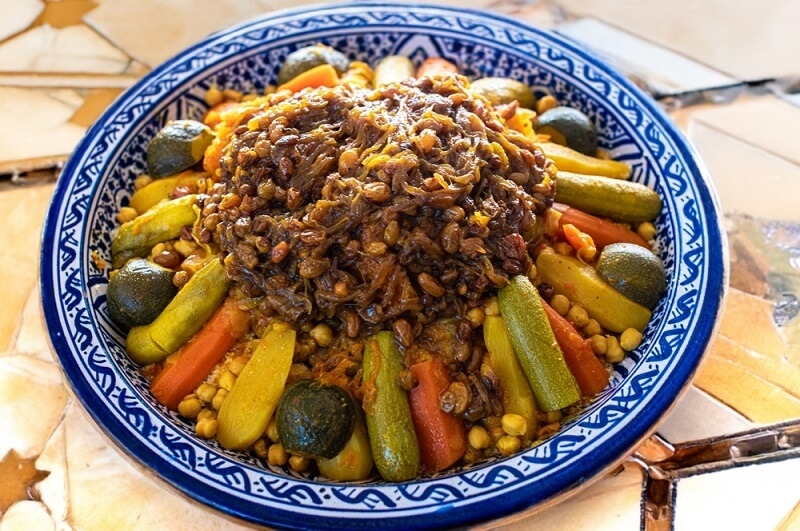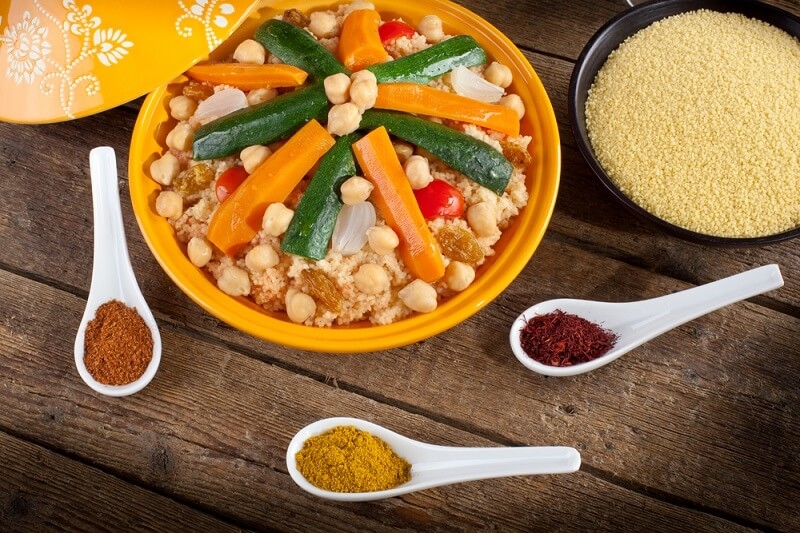
When it comes to hearty and healthy meals steeped in tradition, the Moroccan Couscous Recipe stands out as one of the most culturally important of the traditional North African dishes. It is called a true couscous recipe, and it is cherished as a daily dish and as Moroccan holiday food, which represents a great combination of nutrition, flavor, and tradition. Couscous is not just a culinary dish, but rather symbolizes excitement, family, and the joy of communal eating. While couscous was originally a North African vegetarian meal made with vegetables and legumes, or spiced couscous with chickpeas, it has become an integral part of many people's day-to-day life, hobbies, socializing, and comfort meals across the world.
In this in-depth tutorial, you'll not only know how to make the perfect Moroccan couscous recipe at home but also its history, cultural significance, health benefits, and variations. If you're seeking healthy African recipes or a meal to ravish and impress your guests, then continue reading is your go-to blog.
The Moroccan Couscous Recipe begins with steamed semolina grains that, when prepared properly, end up light, fluffy, and soft. Unlike the quick, speedy store-bought quick cook alternatives, true couscous is to be taken slow through repeated steaming in fragrant broth, absorbing into the depths of the flavours. This due diligence makes plain grains a foundation for colorful vegetables, chickpeas, spices, and occasionally tender lamb or chicken.
For vegetarians, it is then a genuine couscous recipe based on zucchini, carrots, pumpkin, and cabbage – seasoned with warm spices like cinnamon, cumin, turmeric, and paprika. This not only makes a North African vegetarian meal but also a dish that has an unbelievable depth of flavor.
Couscous is more than a dish; it's a tradition. Fridays are commonly the days for family reunions in Morocco, where couscous is the star. It's cooked in huge communal trays, which represent unity and plenty. During weddings, celebrations, and holidays, couscous is the Moroccan celebratory cuisine, accompanied by rich broths, chickpeas, and honey-sweet caramelized onions with raisins.
This ritualistic aspect has declared the dish a UNESCO intangible cultural heritage, symbolizing Morocco's strong tradition of food, family, and celebration. Passing on a Moroccan couscous recipe is more or less passing on the culture of hospitality.
Preparing the dish at home requires fresh and quality ingredients:
This summary addresses why it's sometimes referred to as a North African vegetarian dish – but it's adaptable enough to appeal to most tastes.

In a big pot, sauté onions, garlic, and spices in olive oil until they are fragrant. Add chickpeas and vegetables, then add broth. Let it simmer until the vegetables are soft and the flavors are set.
Instead of boiling, place the couscous grains in a steamer above simmering broth. Steam for 20 minutes, fluff with butter and olive oil, and steam again to get light and airy grains. The process gives the dish a flavor close to an original couscous recipe instead of an instant one.
Place couscous on a big serving platter, make a depression in the center, and spoon vegetables and broth over it. Dress with fresh herbs or caramelized onions and raisins for a classic festive look.
This technique provides you with not just a satisfying meal but a dish that is one of the best healthy African dishes.
For most, the vegetarian version is the grand finale. Spiced couscous with chickpeas pairs rich legumes with aromatic spices, giving it protein content and rich satisfaction. Chickpeas soak up the broth flavor, contributing texture and nutrition.
If you are looking for a North African vegetarian meal that will not weigh you down yet is still filling, this couscous is perfect! It's also an excellent meal-prep choice because it reheats beautifully and goes along with salads or flatbreads.
Several aspects make couscous stand out in the world of healthy African recipes:
Its versatility is the reason that the Moroccan couscous recipe has gained favor on continents.
Though tradition is important, contemporary kitchens tend to be innovative. Some examples include:
These variations show how, even though the original has holy status, couscous can handle plenty of horizontal creativity.
To take your Moroccan couscous recipe to the next level, pair it with:
All of these accompaniments create a full dining experience with couscous, just as you would in Morocco.
Even the most seasoned home cook can face challenges:
Avoiding these all too common errors is likely to let your meal reflect the true spirit of Moroccan festive food.
Moroccan Couscous Recipe is not just a dish; it is a cultural touchstone, a healthy food option, and a favourite dish worldwide. Whether served as spiced couscous with chickpeas or an original couscous recipe, or as Morocco festive food, it embodies sharing, community, and joy; and even as a healthy African recipe, it continues to make chefs and home cooks around the globe go crazy.
To master the recipe is not only to prepare a dish, it is to bring history, Moroccan flavour, and Middle Eastern hospitality to your plate.
Q1. Why is Moroccan couscous different from normal couscous?
Moroccan couscous is steamed several times and flavored with broth, unlike instant couscous, which is rehydrated.
Q2. Can I make a traditional couscous recipe without a couscoussier (steamer)?
Yes, you can use a standard steamer or use a colander over a pot, but you will not be able to duplicate the best texture that a couscoussier produces.
Q3. Is Moroccan couscous always vegetarian?
Not always. While the North African vegetarian dish is common, Moroccan cooking uses meat and poultry versions.
Q4. Is couscous healthy for daily meals?
Indeed. With whole grains, vegetables, and legumes, couscous is one of the healthiest African recipes out there.
Q5. Can couscous be prepared ahead of time?
Yes, couscous reheats well, making it perfect for meal prep or large gatherings.
This content was created by AI